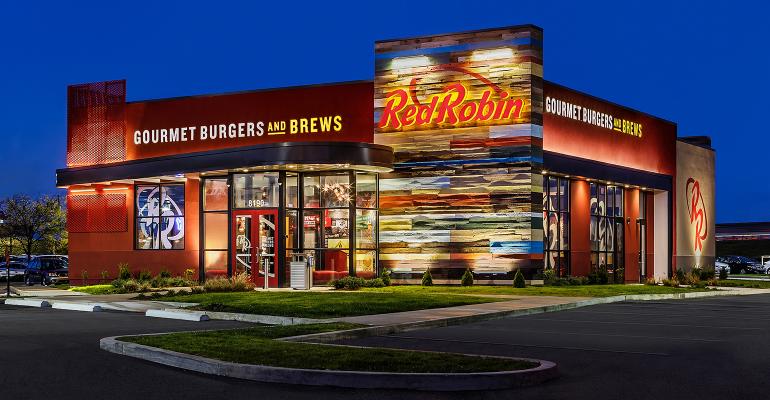Red Robin Gourmet Burgers Inc.’s decision to pause unit growth at the end of 2018 will allow it to shift investments to test new models, company executives said Monday.
The Greenwood Village, Colo.-based casual-dining chain missed on earnings for the third quarter ended Oct. 1, sending its shares plunging Tuesday. Red Robin’s stock was down nearly 30 percent at midday Tuesday, trading at about $47.25 a share compared to Monday’s close of $67.05 a share.
“Consistent with the need to reconsider what has traditionally worked in the past, we recently decided to pause new unit development as of the end of next year,” said Denny Marie Post, Red Robin CEO and president, said in a post-earnings call with analysts. She said the company will still open nine company-owned units in 2018, but put growth on hold after that.
“This will give us 18 to 24 months to sort out what models best meet the needs of our changing guest base, allow us to profitably broaden our reach to more guests, all the while reducing construction and labor costs,” Post said.
Guy Constant, Red Robin chief financial officer, added that general and administrative investments in 2018 would be shifted to innovations, such as the brand’s efforts to build its off-premise dining business and catering.
“As you move away, for example, from developing as many units, you don't need as many of the resources associated with driving that development, and so we're able to repurpose some of those dollars to focus more on innovation,” Constant said. “So I don't see necessarily an overall increase in G&A when you factor all of that in.”
He added that by scaling back unit growth in 2018 and pausing it in 2019 “we certainly free up capital to be able to make those investments.”
Post said that while the company is emphasizing everyday value on its menu, such as expanding the Tavern menu to nine items with three choices at $6.99, Red Robin has been able to avoid discounting on its upper-end items. “Our guests always enjoy the tremendous value of Bottomless Steak Fries or other side choices,” she said.
Red Robin has kept its per-person check average flat, Post added, “which is an investment we believe is worth making. Affordable abundance is a true norm for differentiating factor for Red Robin that we will not cede to competitors who are new to the value game.”
Red Robin has also worked to build its off-premise business, she said, which ended in the third quarter at 7.6 percent of sales, up about 41 percent from the prior-year period. Those off-premise sales, Constant noted, were offset by a 2.5 percent decline in dine-in traffic.
Carin Stutz, Red Robin chief operating officer, said all company restaurants now have online ordering and 98 percent have call-center support. Third-party delivery is available in half the Red Robin locations, she said, and those locations have a range of one to three delivery service providers available. The company is also pilot testing self-delivery, she said, “and we'll learn about it as quickly as we can.”
Post noted that guest demand is shifting to off-premise, particularly home delivery, more rapidly than Red Robin executives had anticipated.
“This option blends guest's dining choices between quick-service, fast-casual and full-service restaurant — independent and chain — like never before, without consideration for convenience of location or that perfect corner,” Post said, adding that Red Robin was addressing those forces “with creativity and urgency.”
Stutz said Red Robin had increased the options by which consumers could patronize Red Robin.
“We have curbside delivery available at over 50 percent of our locations, and we see that maxing out into the low-60s due to lease restrictions,” Stutz said.
“One of the benefits we're quickly realizing with off-premise on our loyalty program is the ability to reach our guests on holidays, where they might not be coming to us to dine in,” Stutz noted. “For the first time that we can remember, we enjoyed positive sales on Halloween.”
Stutz also said the company is working to reduce labor costs, such as piloting the “Maestro” labor initiative that removed expediters in the kitchen.
For the third quarter ended Oct. 1, which included an income-tax benefit, Red Robin swung to a profit of $2.7 million, or 21 cents a share, compared to a loss of $1.3 million, or 10 cents a share, in the prior-year period. Analysts had forecast earnings of 28 cents a share. Revenue in the quarter rose 2.3 percent to $304.2 million from $297.3 million in the same quarter last year, about $5 million less than Wall Street had expected.
Same-store sales declined 0.1 percent in the quarter, driven by a 0.1 percent decrease in average guest check and flat guest counts.
Alexander Slagle, an analyst with Jeffries LLC, said in a note late Thursday that while management still expects positive same-store sales and traffic in 4Q, and “we are modeling for 1 percent same-store sales,” which he noted was less than the consensus of 2.1 percent.
As of Oct. 1, Red Robin had 565 restaurants. Of those, 479 were company-owned and the remaining 86 were franchised.
Contact Ron Ruggless at [email protected]
Follow him on Twitter: @RonRuggless

